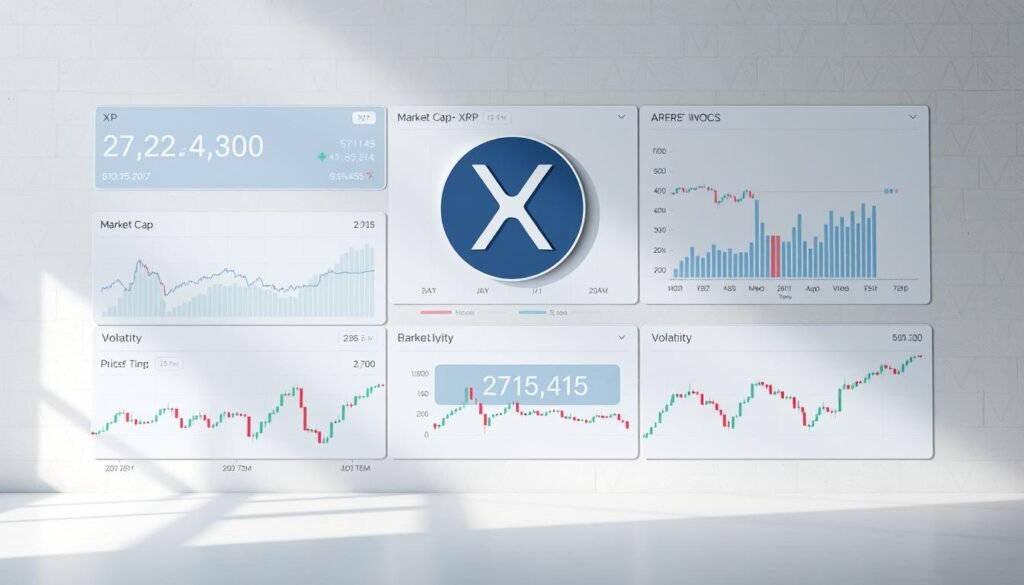Fact: On August 7, 2025, an appeals decision confirmed that XRP is not a security on public exchanges, a ruling that reshaped how U.S. participants view the market.
This short guide explains what that change means today and how it affects onboarding, liquidity, and account access for U.S. residents. You’ll learn what XRP is, how the network works, and why price moves in USD and versus other coins matter when you size positions.
Practical focus: we cover where people access XRP in the United States — major venues like Binance, Coinbase, and Kraken — plus simple steps to open an account and common fees to expect.
The article also outlines risks, liquidity factors, and basic approaches such as trend, range, and momentum methods so you can adapt as conditions shift in the moment.
Key Takeaways
- The appellate outcome clarified regulatory status and boosted exchange support.
- Understand the network utility to judge long-term adoption and demand.
- Compare USD price behavior across coins to plan entries and exits.
- Account setup and liquidity vary by venue; check fees and spreads.
- Use market structure—support, resistance, momentum—to time moves.
What is XRP, the XRP Ledger, and why this digital asset matters for global payments
The XRP Ledger powers a payment-focused crypto network built for speed, low fees, and predictable finality.
Background: The ledger went live in June 2012, created by David Schwartz, Jed McCaleb, and Arthur Britto, with Chris Larsen joining soon after. As a digital asset native to the ledger, XRP was designed to improve cross‑border payments and reduce frictions in legacy rails.
XRPL at a glance: blockchain technology, network design, and low-cost transactions
The ledger uses a consensus design that removes mining and keeps fees tiny. Validators maintain integrity and allow high‑throughput transactions suitable for enterprise use.
Environmental profile: efficient, carbon‑neutral operations for high‑throughput use
Energy efficiency: No proof‑of‑work mining lowers power needs. The project’s offsets and lightweight protocol support a carbon‑neutral posture attractive to institutions.
Speed in seconds: near‑instant settlement for currency transfers and cross‑border use
Ripple introduced On‑Demand Liquidity in 2018. Its solutions can bridge fiat pairs in roughly three seconds, making the ledger practical for remittances, treasury work, and faster payments across venues.
“Predictable finality and low latency make the ledger practical for payments at scale.”
- Fast confirmations measured in seconds.
- Low fees compared with correspondent banking.
- Validators secure the ledger without energy‑intensive mining.
How the consensus mechanism works: security, validators, and network rules
Instead of proof-of-work, this network uses a validator-driven consensus mechanism to confirm transactions quickly and reliably. The design focuses on three principles: Correctness, Agreement, and Forward Progress.
The consensus protocol coordinates validators under explicit rules so nodes agree on an ordered ledger without mining. Each round requires more than 80% agreement among trusted validators to finalize a ledger.
If between 20% and 80% of trusted validators become faulty, the ledger intentionally pauses. This halt protects correctness and prevents invalid state from being accepted.
Validators run on trust lists, which gives the design strong Sybil and 51% resistance under expected assumptions. By prioritizing validity over blind progress, the mechanism lowers reorg risk and improves settlement predictability.
Why this matters: predictable finality and high throughput reduce latency for payments and institutional flows. For U.S. participants moving funds or reacting to market events, faster confirmations improve execution confidence and operational security for the xrp ledger.
Regulatory context and latest news: what the SEC lawsuit outcome means today
The appeals ruling on August 7, 2025 cleared a major legal hurdle and reshaped how U.S. participants access the market.
Post‑appeals clarity confirms that trading the token on public exchanges does not make it a security. This conclusion reduced a persistent lawsuit over listings and helped restore confidence for retail and institutional users.
Market implications and practical effects
Exchanges such as Coinbase, Binance, and Kraken resumed broader support, improving liquidity and lowering spreads for USD pairs. Markets tend to tighten when legal risk is removed, which can improve price discovery around relistings.
Compliance posture for businesses and U.S. participants
Companies and institutions can now evaluate on‑ramp and treasury use cases with clearer exchange access. Ripple Labs continues work on payment solutions, and firms should still consult counsel on custody and rails.
- Check exchange disclosures and state rules before funding accounts in USD.
- Expect shifts in volume and spreads after high‑profile legal news.
- Maintain regular compliance reviews even though the appeals are closed.
Getting started with xrp trading: exchanges, accounts, and order execution
Opening an account and funding it in USD are the first practical steps for accessing XRP markets in the United States.
Choose a reputable exchange that lists XRP—popular venues include Binance, Coinbase, and Kraken. Check security practices, insurance coverage, and proof‑of‑reserves statements. Confirm U.S. eligibility and supported account types before you register.
Complete KYC/AML onboarding and fund the account in usd via ACH, wire, or card. Expect processing times, deposit limits, and occasional fees for different methods.

Fees, custody, and order types
Fees: Review maker/taker schedules, volume discounts, and network withdrawal transaction fees when moving coins off an exchange.
Custody: Keep assets on an exchange for short‑term access. Use self‑custody wallets with secure backups for longer holds.
Orders: Learn market, limit, stop, and OCO orders. Size positions using a clear risk per trade and set predefined exits to manage downside.
Derivatives and execution risks
Perpetuals and futures appear on some platforms. Verify margin requirements, funding rates, and liquidation rules. Use conservative leverage to limit downside when using these products.
| Exchange | Market Access | USD Funding | Typical Fees |
|---|---|---|---|
| Coinbase | Spot, limited derivatives | ACH, wire, card | Maker/taker tiers; withdrawal network fee |
| Binance | Spot, perpetuals, futures | Wire, card | Low maker fees; volume discounts; network fees |
| Kraken | Spot, futures | ACH, wire | Competitive tiers; staking and withdrawal charges |
“Compare market depth and spreads across venues to reduce slippage and improve execution.”
Trading strategies and tools: from trend to range, resistance and momentum
A clear timeframe makes it easier to read support and resistance and act with conviction. Decide if you will be intraday, swing, or position-focused and pick indicators that suit that horizon.
Note: technical ratings can differ by timeframe. One snapshot might read “sell” for today, “buy” for 1‑week, and “buy” for 1‑month. Use those ratings as a starting point, not the final decision.
Timeframes and tactics
Intraday setups favor fast moving averages and volume spikes. Swing methods pair daily structure with trend filters. Position approaches use weekly support and macro flows.
Support, moving averages, and price action
Map horizontal support and resistance, add a 21/50 MA to define trend, and wait for confirmation before entry. Failures at resistance often offer lower-risk short opportunities.
“Combine momentum with volume to judge when a new wave of trend acceleration is likely.”
- Choose a primary timeframe and match risk per trade to that horizon.
- Use moving averages and support/resistance to define structure and entry triggers.
- Blend momentum indicators with volume to confirm breakouts versus fakeouts.
- Keep a written plan: entry, invalidation, and targets; review performance regularly.
| Approach | Tools | When to Use |
|---|---|---|
| Intraday | Short MAs, volume, order flow | High liquidity sessions, fast setups |
| Swing | Daily MAs, RSI, support/resistance | Trend-following and range trades over days |
| Position | Weekly MAs, macro context, on‑chain cues | Long-term exposure to assets and ecosystem developments |
Practical tip: incorporate broader crypto market context and xrp ledger developments as catalysts, but validate signals with liquidity and order‑flow before you execute.
XRP price today: market cap, volume, and volatility context for U.S. traders
A quick data snapshot helps you set position size and risk limits with real numbers rather than guesswork.
Live market snapshot: price in USD, trading volume, and recent performance
Current quote: the xrp price sits at 2.76090 USD, down −0.44% over 24 hours. Use this to calibrate entry slippage and stop distances in the moment.
Liquidity and scale: market capitalization is 164.22 B USD with 24‑hour volume near 3.74 B USD. Those levels point to active liquidity that can improve execution across major markets.
Recent performance varies by horizon: −8.65% week, −6.61% month, and +387.70% year. The all‑time high of 3.66596 USD on July 18, 2025 is a useful reference for upper supply zones.
Estimated volatility today is about 5.10%. Set stops and risk budgets accordingly, especially when using leverage.
“Track how news flow aligns with volume spikes and range expansions to anticipate when liquidity may improve or spreads may widen.”
- Verify price and depth on your venue—coins can show venue‑specific prints.
- Use market cap and volume to judge if intended size will move the book.

| Metric | Value | Why it matters |
|---|---|---|
| Price (USD) | 2.76090 | Entry and stop placement reference |
| 24h Change | −0.44% | Short‑term momentum cue |
| Market Cap | 164.22 B USD | Liquidity and relative size |
| 24h Volume | 3.74 B USD | Execution and slippage indicator |
| Estimated Volatility | 5.10% | Risk sizing and stop distance guide |
Ripple solutions for businesses: On‑Demand Liquidity and real‑world payments
Ripple’s enterprise products aim to shrink settlement time and free up capital for corporate treasuries. On‑Demand Liquidity (ODL) uses the xrp ledger to move value between currencies in roughly three seconds, cutting the need for pre‑funded accounts.
ODL for cross‑border transactions: bridging assets in seconds
How it works: ODL sources liquidity on demand to bridge a send and receive currency pair in seconds. This reduces trapped capital and shortens cash conversion cycles for businesses that run frequent cross‑border operations.
Liquidity management, transparency, and costs at scale
Benefits for businesses: better liquidity management, clearer transaction trails, and lower operational costs. By using a blockchain settlement model, reconciliation is simpler and timing becomes predictable for finance teams.
- ODL expanded to dozens of payout corridors by 2021, improving coverage for global payments.
- Machine‑learning routing and enterprise integrations optimize cost and speed in volatile currency markets.
- Consistent settlement status reduces intermediary steps and eases compliance reporting.
“Real‑world transactions benefit from consistent settlement and clear status updates, helping finance teams manage cash cycles with fewer intermediaries.”
Developers and the community: XRPL ecosystem, NFTs, and long‑term utility
A thriving developer scene and active community keep the XRPL evolving beyond payments. Open source code, clear docs, and public tooling let builders move from prototype to production quickly.
Where to start: developers can use xrpl.org for documentation, visit GitHub for source repos, and inspect live activity on the livenet.xrpl.org explorer. These resources reduce onboarding time and lower integration risk.
- Builder resources: SDKs, test networks, and reference implementations speed development of wallets, payment rails, and token contracts.
- Creator support: Ripple’s $250M Creator Fund boosts adoption of nfts and media projects by offsetting launch costs and attracting partners.
- Proven stack: with years of production history and ODL scaling to nearly 40 payout markets in 2021, the network shows commercial traction.
The ecosystem also benefits traders and holders: active contributors publish guides, marketplaces, and integrations that can extend token utility and give coins more on‑chain functionality.
“Open documentation and community funding make it easier to build sustainable apps on the ledger.”
Risk management and security: protecting your coins, accounts, and transactions
Security is a process, not a feature — build it into every step of how you move assets. Start by treating key management and platform choices as core controls. Small, consistent habits cut the chance of loss and make recovery easier if something goes wrong.
Operational security and account controls
Enable hardware keys, use unique strong passwords, and store recovery phrases offline. Keep device OS and wallet software updated and avoid public Wi‑Fi for sensitive actions. Beware of phishing and unsolicited “support” outreach.
Exchange risk, custody, and company disclosures
Diversify custody between reputable platforms and self‑custody to reduce single‑company risk. Review exchange insurance, incident response, and proof‑of‑reserves regularly. Know withdrawal rules and downtime policies before you fund accounts.
Navigating transactions, validators, and market events
Verify addresses and memos; send small test amounts before moving large balances. Confirm settlement on the xrp ledger explorer when needed. Monitor validator dashboards — the protocol halts progress if 20–80% of trusted validators are faulty to protect correctness.
“Technical indicators can diverge across timeframes; intraday ratings may show sell while weekly and monthly show buy, so size risk accordingly.”
- Build rules for risk per trade and total exposure so price swings won’t endanger your plan.
- Align stops and hedges with your time horizon and anticipated volatility around policy or macro events.
- Regularly review platform announcements, insurance terms, and operational health to stay informed.
Conclusion
When markets move, the combination of clearer rules and fast settlement matters more than ever. The August 7, 2025 appeals outcome reopened exchange access and helped restore confidence for U.S. participants. Anchor any plan to the xrp price in USD and the venue you use.
Use disciplined risk rules, verify depth on exchanges, and keep custody choices simple. The ledger’s consensus mechanism and validators protect transaction integrity, while ODL bridges currency pairs in roughly three seconds for payments at scale.
For builders and businesses: visit xrpl.org and GitHub for docs, tools, and community resources to build nfts, apps, or payment flows. Revisit your assumptions over time and plan for market waves rather than a single snapshot.
FAQ
What is XRP and why does the XRP Ledger matter for global payments?
The token is a digital asset built for fast, low-cost value transfer. The XRP Ledger (XRPL) is an open, decentralized ledger that supports high-throughput transactions and near-instant settlement, making it useful for cross-border payments and liquidity routing for businesses and financial institutions.
How does the XRPL consensus protocol differ from proof-of-work?
Unlike energy-intensive proof-of-work, XRPL uses a consensus mechanism where validators agree on ledger state through rounds of voting. This delivers deterministic finality in seconds, high throughput, and much lower energy use while preserving data integrity and transaction order.
Is the network environmentally friendly?
Yes. The consensus design requires far less computational effort than mining-based systems, producing a small carbon footprint per transaction and supporting carbon-neutral operational profiles suitable for scalable payments.
How fast are transactions on the ledger?
Typical settlement completes in a few seconds. That speed enables rapid currency transfers and helps reduce counterparty and settlement risk for remittances and interbank flows.
What role do validators play and how is network security maintained?
Validators run nodes that participate in consensus by validating and voting on ledger proposals. Security comes from diverse, well-managed validators and trust lists that limit Sybil attacks and help maintain resistance to 51% control while ensuring correct forward progress.
What happens if a validator misbehaves?
Misbehaving nodes can be excluded from trusted lists and their votes ignored. The protocol’s design ensures consensus can continue if a subset of validators act maliciously, protecting finality and transaction continuity.
How did the SEC lawsuit outcome affect market access and regulatory clarity?
Recent rulings provided clearer guidance about how the asset is treated on public exchanges, reducing uncertainty for some market participants. However, regulatory posture varies by jurisdiction, and businesses should follow local compliance rules when listing or using the token.
Can U.S. traders and firms use the token freely now?
Many U.S. firms resumed or maintained services after clarifications, but compliance requirements remain. Firms must perform KYC/AML checks and follow domestic securities and commodities rules as applicable. Legal counsel and up-to-date guidance are recommended.
How do I choose an exchange to buy or sell the asset?
Pick a licensed, high-liquidity exchange with strong security measures and transparent fees. Major global venues such as Coinbase, Kraken, and Binance offer broad market access, but compare custody options, withdrawal limits, and USD funding methods before committing.
What funding and custody options should I consider?
You can fund accounts via bank transfers, debit/ACH, or stablecoin rails. Custody options include exchange-held wallets, regulated custodians, or self-custody hardware wallets. Weigh convenience, security, insurance, and regulatory protections.
What order types and markets are available for traders?
Spot markets, perpetual swaps, and futures exist on different platforms. Order types include market, limit, stop, and OCO. Choose instruments and position sizes that match your risk tolerance and always use risk controls like stop-losses.
Which trading strategies suit this asset’s market behavior?
Strategy choice depends on timeframe. Intraday traders use momentum and scalp tactics; swing traders rely on trend and support/resistance; position traders focus on fundamentals and long-term adoption. Combine technical indicators with strict position sizing.
How do support and resistance, moving averages, and momentum align with price action?
Use moving averages to define trend direction, RSI and MACD for momentum, and previous highs/lows for support and resistance. Align indicator signals with timeframes and volume to avoid false breakouts and reduce drawdowns.
Where can I view live market data like price, volume, and market cap?
Real-time quotes and historical charts are available on major exchanges and market data sites like CoinMarketCap and CoinGecko. Check USD pair liquidity, 24-hour volume, and order-book depth to assess execution risk.
What is On-Demand Liquidity (ODL) and how do businesses use it?
ODL is a payments service that sources liquidity on-demand by converting fiat to the token, transmitting value across rails, then converting back to the destination fiat. It reduces the need for pre-funded accounts and can lower settlement times and costs for cross-border flows.
How do companies evaluate liquidity management and costs with ODL?
Firms measure spreads, exchange fees, volatility risk during conversion, and settlement speed. Good liquidity partners offer transparent pricing, strong counterparty controls, and integrations that minimize slippage and operational overhead.
What developer tools and resources support the XRPL ecosystem?
The community maintains open-source code and SDKs on GitHub, plus REST APIs, JavaScript and Java libraries, and documentation. Testnets and developer forums help builders prototype payments rails, wallets, and smart contract-like features such as hooks.
Are NFTs and creator tools supported on the ledger?
Yes. The ledger supports token issuance and NFT-like assets with low fees and fast settlement, enabling creators and media companies to mint, transfer, and manage digital collectibles with lower per-item costs than many competing chains.
How should users protect their accounts and assets?
Follow operational security best practices: enable hardware wallets for self-custody, use reputable custodians with insurance, employ strong passwords and 2FA, and avoid reusing keys. Monitor exchange announcements and withdraw funds to secure custody when appropriate.
What are the biggest risks participants should watch?
Market volatility, counterparty failure at exchanges, regulatory shifts, and smart operational mistakes are primary risks. Diversify custody, use position limits, and stay informed about network upgrades and legal developments to manage exposure.



